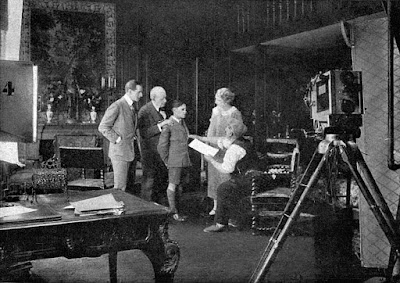Max de Rieux is indeed already known on the screen with two main roles in prestige films. One is another adaptation by the same author, directed by André Hugon: Le petit chose, and the other is Les Grands by Henri Fescourt. His next film to be released has already been shot: How I Killed My Child by Alexandre Ryder.
If we are to believe Le Gaulois of June 8, 1923 (which announces the shooting) and Comœdia of April 3, 1925 (which announces the upcoming presentation), he also shot with the same André Hugon a film entitled Le saphir blanc with "A . Toulout "(Jean?), And Mlle Gray (Florence, Irma, Minia, Sylvia?) From a short story by Raymond Genty. But I can no longer find any trace of this film beyond these two publications. Still, the jack-of-all-trades actor, already very active on stage, will soon go behind the camera to direct his own films.
The other actors are, as usual and in part, used to working with Saidreau: André Dubosc is returning for at least the 4th time, Yanne Exiane for the second and will end her career on the screen here, just like Suzanne Balco and Émile Garandet who collaborate with the director for the third time.
Thérèse Kolb has apparently never played in Saidreau's films, but she shared the screen with him in Blanchette, where she played the mother.
Among the newcomers, however, we must point out Alexiane, noticed in Le lion des Mogols and that we will see again in The Chess Player, Roger Tréville who will make a career in the early French talkies, then in dubbing as the voice of James Stewart and Robert Mitchum. Finally, of course, two musketeers from Henri Diamant-Berger's films: D'Artagnan - Jean Yonnel (Twenty Years After) and Porthos - Thomy Bourdelle (The Three Musketeers).
Shotting
It seems that the filming continues at the castle of Étiolles. It may be that this is the Château du Parc de la Pompadour, which we find online was bought in 1908 by an owner who had it destroyed. If so, the building was still standing in 1925.
The exteriors are then planned in Indret, an island located at the time in the Lower Loire, today in the Atlantic Loire, where there is an old foundry and where the novel is located. On May 30, the exteriors are completed according to L'Intransigeant. According to Le Petit Parisien, it has been a done deal since August 1.
 |
| Yonnel, Dubosc, Forest, Exiane and Saidreauon the set of Jack |
Release
But lo and behold, on December 5, 1925, Robert Saidreau died. The press of the time says he was 50 years old, although he seems to have only been 48.
It was not until January 22, 1926 that Jack came out at the Palais des Fêtes and the friend of the director René Jeanne estimated in Le Petit Journal released that day that "Jack will certainly experience a good emotional success.". We then find the film on March 21, at the Eden in Vincennes, and on April 23 at the Odeon in Marseille.
Meanwhile, on February 20, 1926, a journalist from L'Intransigeant regretted that Saidreau's name did not even appear on a poster of the film he saw.
On November 6, 1925, in Cinémagazine, one can admire a beautiful poster of the film reproduced in on a double page where the name of Saidreau is clearly visible.
To read the last chapter on the work of director Robert Saidreau, click here.
Click "Like" on the Facebook page if you like my blog.
That's all for today folks! See you soon !
